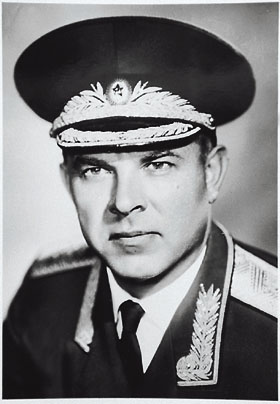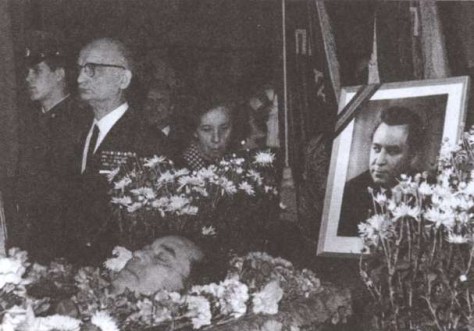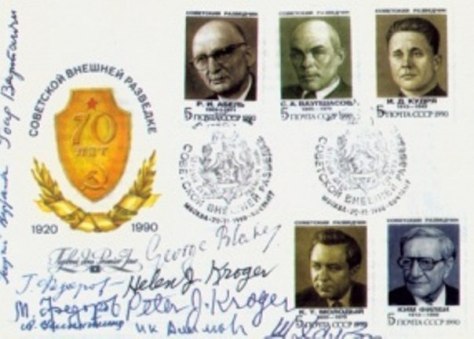How did the KGB train its deep-cover officers to pose, operate and live under the guise of foreign nationalities? Former KGB Chairman Vladimir Efimovich Semichastny (1924-2001) describes how the KGB First Chief Directorate’s elite Directorate S processed, prepared and deployed illegal officers for work abroad in the field – without the protection of the Soviet embassy or Moscow Center.
Our nation’s intelligence was distinguished by one particularity that could be discovered only extremely rarely in the practices of other secret services. This concerns the training and use of so-called “illegals” – Soviet citizens who settled in other countries under assumed names, thereby allowing us to create the consummate agent network. Such a network couldn’t be uncovered by the Western counterintelligence services that were orbiting mainly around our embassies; representations; trade missions; bureaus; and press agencies.

Inasmuch as I am aware, illegal agents who themselves recruited information sources were written about in relation to the GDR [German Democratic Republic – East German] intelligence service and its actions against the West Germans. Yet there, with the presence of two German states, the situation was much more simple than with us.
I don’t know whether the Germans in Berlin trained their illegals the same way we did. I only know that their secret agent networks were managed on the basis of the same principle we used when directing a network of our illegals. Concretely this meant the use of agents directly from the Center, and not at all through the residency in Bonn.
Along with that, the agent – a West German – used neither another name, nor another’s biography.
I myself wouldn’t begin a conversation on such a topic, because I don’t share the opinion that with the collapse of the Soviet Union there’s come an end to competition between particular secret services. Many technologies must be used in the future, if in different political conditions.
The secret of our illegals was one of our most scrupulously guarded treasures. However, in recent times, several former Chekists have spoken in the Russian media, revealing the training technology for our illegals in order to make some extra money. I don’t think it follows to keep everything a great secret as it was done earlier, but we must remember the security of our own colleagues who work or simply live in the West, and also remember that disclosing the secrets of espionage could prove a detriment our special services. Instead of helping to understand history, it could turn out to be a successful instruction for terrorist organizations or various mafias, of which there are rather many today. Therefore I will stop only on that which has come to the surface in other print publications.
The training of illegal agents was not a mass affair, and all of it represented a very complex, expensive, and at times drawn-out process. The task was set to prepare a Soviet intelligence officer for human intelligence work so that he didn’t distinguish himself in any way from residents of one or another Western country, particularly the United States, Great Britain, France, or Germany. Beginning with polished speech without any accent and ending with such minor details such as the habit of tying the laces on one’s boots, for example. A Russian, as we know, usually conducts this simple operation by squatting, while a foreigner will first off look for where to set his foot, only then leaning down to his shoes.
Our conventional residents responsible for supplying human intelligence from a given territory were not informed about our illegal agents. An illegal was directed from Moscow Center. Meetings with him were undertaken during either his secret visits to the USSR or in some other state, but not where he lived permanently. Understandably, only a narrow circle of people at Lubyanka itself knew about them.
Work with each selected candidate was purely individual. It was best of all to begin training before the person would turn 30. Then, after training and resettlement to a different country, the intelligence officer could still work for a long period. But on the other hand, it was impermissible to begin training too early: a twenty-year-old person would still be too young for us to choose him. To determine whether he’d be suitable to the forthcoming work or not could only be done around 30 to 40 percent of the time.

A person who became a candidate should have already demonstrated beforehand quickness of intellect, high erudition, an ability to study languages, and other key capabilities. During training we controlled and corrected almost every one of his moves. A large number of potential illegals, and perhaps even the majority, ultimately didn’t reach the final objective.
It was bitter when a person, in whom we had invested much time, funds, and efforts, didn’t vindicate our hopes. Yet a minor thing such as speaking Russian in one’s sleep was sufficient for us to have to reject a candidacy. In addition, a future illegal was not to have loved drinking or chasing skirts too much.
The instructors and teachers of future illegals were both psychologists and pedagogues. For example, language instructors. The time for training was not standard: for one person four years was enough, while another needed six or seven. We trained “authentic” Americans and Englishmen on Soviet territory. Habits of how to fill out forms in a London post office; how to pay for an apartment in New York; where in Bonn to drop in on one’s own, and where one could ask for help; how tax declarations in Paris are filled out – all of this we taught right in the capital of the Soviet Union or on its outskirts.
While future illegals were diligently studying, our residencies abroad were also not sleeping. A trained illegal was to become one in actuality, not turn into an emigre or the usual agent. Only a flawless legend could make our man such an “Englishman from birth,” and its roots could reach back decades.
Abroad it followed to first find a suitable basis for a legend. One of the possible solutions was to find the grave, of a child, we’ll say, who died in infancy. Then the future illegal would receive the name that was on the child’s gravestone, and along with it a concrete date and place of birth. Then we needed to ensure the disappearance of the infant’s name from the registry of the departed in the corresponding church book. The best option was when the child was born in one place but died in another. In such a way several church books with records on the given person would turn up, and their comparison was practically impossible. If a Western counterintelligence service suddenly wanted to check concrete information about the suspect, then by all means, it was noted that such-and-such was indeed born in the given place. Who would search for whether this person randomly died in a completely different place and in a different state of the country?
Erasing the corresponding record in a church book was usually just a question of the sum required. Of course, with that we conducted business with the most simple and understandable motivation. Every move was based on one or another well-thought-out legend: in one case the matter concerned an inheritance and big money, while in another something most suitable would be thought up at the given moment. Here fantasy played the role, and technique acted it out. But primarily, a legend had to be absolutely natural, and there would be no room left for romantic stratagems.
However, more than once it happened we were unable to get to the appropriate documents, the planned biography didn’t take, and under closer examination, it could have been uncovered by Western security agencies. However difficult it was, we nevertheless had to start from the beginning again. There couldn’t be another solution – founded on underestimation of the opponent – otherwise, many months or years later, we’d have to pay a dear price for failure. And there wasn’t anything terrible that out of ten attempts, only one succeeded. This was more proof that illegals didn’t appear off of an assembly line.
When all the facts were prepared how they should have been, and the candidate proved sufficiently capable and could start working, the time came for our technical service to show itself. The preparation of necessary documents began.
The new citizen, say an American, received a birth certificate that was impossible to differentiate from other similar documents: this related both to the type and age of the paper, as well as the ink used.
Our intelligence got the paper of American paper mills, and then, with special barrels plus chemical additives and complex technologies, this paper began to artificially age. In such a way any other forged documents were produced: a copy from a French birth certificate, just like Finnish driving documents, couldn’t be produced on paper from a factory in 1960’s Archangel.

At the end of this whole long process, the illegal would hold in his hands an old, worn passport with a multitude of stamps and visas, although the document was actually brand new.
The time came to unite the man and the legend in practice. To imagine that the illegal would move to a new place, buy himself a new house and arrange fancy parties with influential, ranking people is totally naïve.
In appearance an illegal would often look like a failure who at first would be unlucky; he could go bankrupt, raise his head above water and then plunge downward again. Incrementally he’d connect with people who would help him – somewhere they’d give him a recommendation, somewhere else they’d move him forward. (We found ways to help with respect to finances.) And only some time later, our man would stand on his own legs, and then would begin the period of his agent-running activity.
Work Translated: Семичастный, В. Е. Беспокойное сердце. — М.: Вагриус, 2002.
Translated by Mark Hackard.


Thank you for your work, Mark. A great site you have here I intend to read every article))
LikeLike